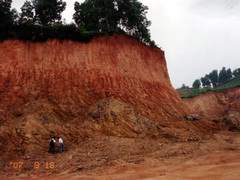Bulletin of the Geological Survey of Japan Top Page
Bulletin of the Geological Survey of Japan Vol.65 No.1/2 (2014)
Cover photograph | Table of Contents | Abstract
Cover photograph
Weathered crust of the Triassic granites, REE-bearing saprolite
Ion-absorption-type REE ores occur widely in weathered crust of the various granites of mainly Yanshanian (Jurassic- Cretaceous) age in southern China. The same possibility is seen in the granitoids of northernmost Vietnam, because the weathering is also well-developed. The host granite was here dated to belong to Triassic in age. REE-bearing clay-rich saprolite has been developed so thick that the age could be older than Quaternary.
(Photograph and Caption by Shunso Ishihara)
Table of Contents
All the pages PDF : 65_01_full.pdf [7.3MB]
| Title | Author | |
|---|---|---|
| Article | ||
| Identification of volcanic glass bearing Daisen-Kurayoshi tephra (DKP) from borehole core at Horinji, Nanto City, Toyama Prefecture, and its implications for estimating long-term slip rate on active faults in the Hokuriku region |
Tadashi Maruyama and Masaru Saito (p1-9)
|
65_01_01.pdf [1.1MB] |
| Report | ||
| K-Ar age determinations of ageunknown rocks in the Japanese Islands -igneous rocks in the areas associated with Geological Map Project (fiscal 2012 version)- |
Akikazu Matsumoto, Yutaka Takahashi and Hideo Hoshizumi(p11-16)
|
65_01_02.pdf [2MB] |
| Short Article | ||
| Zircon U-Pb age of the Triassic granitoids at Nui Phao, northern Viet Nam |
Shunso Ishihara and Yuji Orihashi (p17-22)
|
65_01_03.pdf [3.2MB] |
Abstract
Identification of volcanic glass bearing Daisen-Kurayoshi tephra (DKP) from borehole core at Horinji, Nanto City, Toyama Prefecture, and its implications for estimating long-term slip rate on active faults in the Hokuriku region
Tadashi Maruyama and Masaru Saito
We report occurrence and petrological characteristics of the Daisen-Kurayoshi tephra (DKP;≥55 ka), a late Pleistocene widespread tephra in Japan, identified from borehole cores at Horinji, Nanto City, Toyama Prefecture, drilled for defining shallow subsurface geometry of the Horinji fault. DKP found from the cores contains abundant volcanic glasses compared with the heavy minerals such as orthopyroxene and hornblende, whose occurrence is very rare because the glasses are commonly altered into clay minerals. Range of refractive index of the volcanic glass, reported for the first time in and around Hokuriku region including Toyama, as well as that of orthopyroxene and hornblende, is similar to that of the source area. Result of pollen analysis of organic silt just below DKP suggests that the silt was accumulated under cool climatic condition correlated with the period of marine oxygen isotope stage (MIS) 3. Identification of intact DKP from downthrown side of the Horinji fault implies that the precise correlation of the strata or terrace surfaces of MIS 3 separated by faulting might be possible through detailed examination of the strata with tephra and pollen analyses, which provides basis for determining more reliable long-term slip rate of active faults in the Hokuriku region.
K-Ar age determinations of ageunknown rocks in the Japanese Islands -igneous rocks in the areas associated with Geological Map Project (fiscal 2012 version)-
Akikazu Matsumoto, Yutaka Takahashi, Hideo Hoshizumi
In order to construct accurate geological maps of Japan, K-Ar ages of five plutonic rocks have been determined during fiscal 2012 by the geochronological laboratory of Geological Survey of Japan, AIST. The crystals of biotite in five plutonic rocks were isolated by using an isodynamic separator and tapping processes. Each data of rock samples determined is associated with rock name, locality, collector, geological setting, K-Ar age, analytical data and geological interpretation.
Zircon U-Pb age of the Triassic granitoids at Nui Phao, northern Viet Nam
Shunso Ishihara and Yuji Orihashi
Rock-forming zircon was separated from so-called Triassic granitoids at Nui Phao in the northern Viet Nam, and the contained zircons were dated by LA-ICPMS U-Pb method, as the earliest Triassic of ca. 250 Ma. This new results are suggestive to identify the formation ages of Sn-W and REE ore deposits hosted in the granitoids.
Geological Survey of Japan, AIST
- About GSJ
- Our Activities
- Purchase guide
-
Publications and Database
- information
- Bulletin of the Geological Survey of Japan
- bull2025(Vol.76)
- bull2024(Vol.75)
- bull2023(Vol.74)
- bull2022(Vol.73)
- bull2021(Vol.72)
- bull2020(Vol.71)
- bull2019(Vol.70)
- bull2018(Vol.69)
- bull2017(Vol.68)
- bull2016(Vol.67)
- bull2015(Vol.66)
- bull2014(Vol.65)
- bull2013(Vol.64)
- bull2012(Vol.63)
- bull2011(Vol.62)
- bull2010(Vol.61)
- bull2009(Vol.60)
- bull2008(Vol.59)
- bull2007(Vol.58)
- bull2006(Vol.57)
- bull2005(Vol.56)
- bull2004(Vol.55)
- bull2003(Vol.54)
- bull2002(Vol.53)
- bull2001(Vol.52)
- Bulletin of the Geological Survey of Japan(old)
- Annual Report on Active Fault and Paleoearthquake Researches
- Reports, Geological Survey of Japan
- CCOP-GSJ Groundwater Project Report
- CCOP Technical Bulletin
- Cruise Report
- Geological Hazards
- Learning and Education
- GSJ Database Collection
- Collection of links


